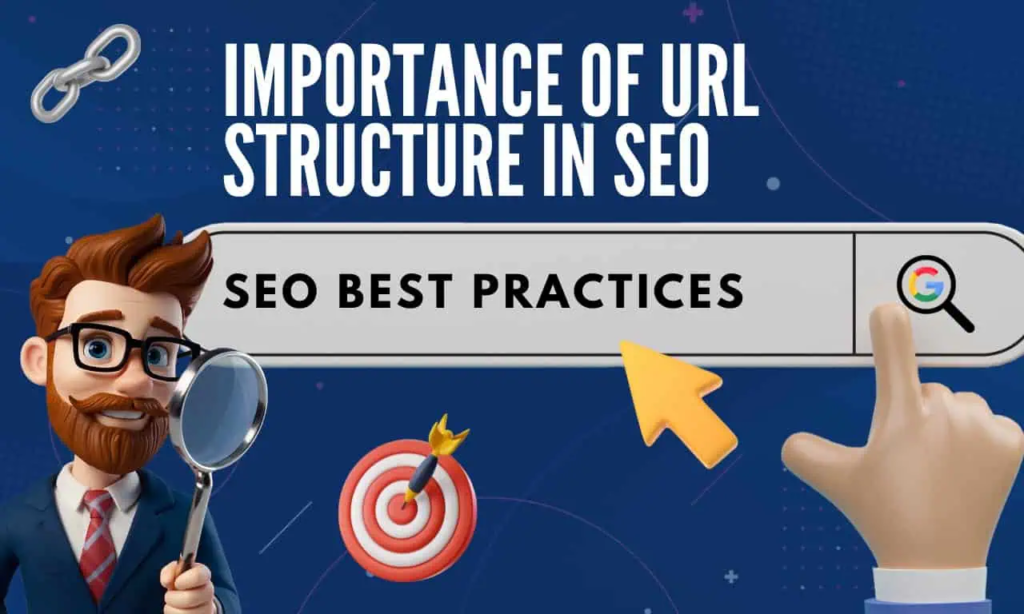
Introduction
In the competitive world of digital marketing, every small detail matters when it comes to ranking higher on search engines and improving user experience. One of the most underestimated yet highly impactful elements is the URL structure for seo of your website. Just like a strong foundation holds up a building, a well-structured URL supports better site visibility, crawlability, and trustworthiness in the eyes of both users and search engines. At Anshfluance Media (https://anshfluancemedia.com/), we specialize in optimizing every detail of a website—including its URLs—to ensure strong SEO performance.
Understanding the importance of URL structure SEO is essential for business owners, digital marketers, and web developers. Whether it’s improving the readability of your SEO-friendly URLs, enhancing crawl efficiency, or signaling relevance to Google’s algorithms, your URL plays a foundational role. When you optimize URL structure, you help search engines categorize your content correctly and ensure users know what to expect before clicking your link.
This guide will walk you through what makes a search engine friendly URL, the role of keywords, differences between clean and messy URLs, and common mistakes to avoid. If you’re serious about organic growth and digital success, mastering URL optimization for SEO is not optional—it’s essential
What Is URL Structure?

A URL (Uniform Resource Locator) is more than just a web address—it’s the digital path that directs both users and search engines to specific content on your website. The URL structure for SEO experts recommend is one that is simple, logical, and easy to understand for both humans and bots. At Anshfluance Media, we define URL structure as the format and layout of your website links, including domain name, folders, and page names.
An ideal SEO-friendly URL follows a consistent structure that reflects the website’s hierarchy and the relevance of its content. For example, a well-structured URL like:
bash
CopyEdit
www.example.com/blog/url-structure-seo
…clearly communicates what the page is about. Compare that to a messy, unclear link like:
bash
CopyEdit
www.example.com/page?id=987
…which lacks context for both users and search engines.
Proper URL optimization for SEO helps search engines crawl and index your site efficiently. It enhances the user experience by making URLs readable and trustworthy. Including targeted keywords in your search engine friendly URL further strengthens on-page SEO.
Ultimately, when you optimize URL structure, you build a navigable, professional, and SEO-aligned site. As part of URL best practices SEO, using hyphens instead of underscores, avoiding keyword stuffing, and keeping URLs short and descriptive is crucial. This foundational step is often ignored, but at Anshfluance Media, we know it’s a game-changer.
How Search Engines Read URLs

Understanding how search engines interpret your URL structure is essential to mastering the URL structure for SEO. When a search engine like Google crawls your website, one of the first things it examines is the page’s URL. This URL acts as a signal, giving clues about the content’s relevance, topic, and hierarchy. At Anshfluance Media, we emphasize designing a search engine friendly URL that helps bots easily discover, crawl, and index your web pages.
A clean, logical URL structure allows crawlers to map the layout of your website efficiently. It helps them categorize your content correctly, which improves your chances of ranking for relevant queries. For example, a URL like:
bash
CopyEdit
www.website.com/services/digital-marketing
…immediately signals what the page is about, making it easier for algorithms to rank your content under the right category.
Additionally, URLs are often used in sitemaps and appear in SERPs (Search Engine Results Pages), which makes them even more critical from an SEO-friendly URLs standpoint. Poorly constructed URLs, filled with unnecessary parameters or random characters, confuse search engines and dilute keyword signals.
By focusing on URL optimization for SEO, you also reduce crawl errors and improve internal linking. This, in turn, strengthens your entire site architecture. Search engines prefer consistency, and by following URL best practices SEO, like lowercase letters, hyphens between words, and short paths, you’re creating a more crawlable and rankable site.
In short, if you want your pages to rank higher and be found faster, you must optimize URL structure with clarity and intent. This isn’t just technical advice—it’s a core part of your SEO strategy. And at Anshfluance Media, it’s something we implement from day one.
The Role of Keywords in URLs

Using keywords in URLs is one of the most overlooked but effective on-page SEO tactics.. At Anshfluance Media, we always advise clients to embed primary keywords naturally into their SEO-friendly URLs to improve discoverability and boost rankings.
Including keywords in your URL structure SEO plan helps search engines better understand the content’s topic. For example:
bash
CopyEdit
www.example.com/social-media-marketing-tips
. It supports your content’s main focus and aligns with search intent.
Avoid keyword stuffing. A single, well-placed keyword aligned with your content is more effective for URL optimization for SEO than overloading it with multiple terms. This also improves readability and trust.
Remember:
Use hyphens to separate words
Keep it lowercase
Avoid stop words like “and”, “of”, or “the” unless absolutely necessary
At Anshfluance Media, we incorporate keywords into URLs as part of every content strategy. It’s a small move that makes a significant impact on both traffic and trust.
Clean vs. Messy URLs: What’s the Difference?
The difference between a clean and messy URL can make or break your SEO strategy. A clean URL is short, readable, keyword-focused, and easy to understand. It looks like this:
bash
CopyEdit
www.example.com/about-us
On the other hand, a messy URL is filled with random numbers, parameters, or special characters:
bash
CopyEdit
www.example.com/index.php?id=456&user=xyz
At Anshfluance Media, we guide clients to build clean, SEO-friendly URLs that serve both technical and user experience goals.
Why are clean URLs important?
They’re easier to read and remember
They improve click-through rates in search results
They help search engines categorize content correctly
Messy URLs, on the other hand, confuse users, discourage clicks, and reduce SEO relevance. Google and other engines may find them harder to index.
Following URL best practices SEO involves:
Using hyphens (not underscores)
Removing unnecessary parameters
Keeping it short and descriptive
Including a relevant keyword
When you optimize URL structure to be clean and concise, you’re not only improving SEO—you’re making your brand appear more trustworthy and professional.
Best Practices for SEO-Friendly URLs

To get the most out of your URL structure SEO strategy, follow these proven best practices—the same ones we use at Anshfluance Media for every client website:
1. Keep it short and meaningful
A good URL should describe the page in a few simple words.
2. Use keywords wisely
Include one or two main keywords related to the content. Don’t overstuff.
3. Use hyphens to separate words
Search engines treat hyphens as word separators; underscores are not recommended.
4. Avoid special characters and numbers
Stick to clean, readable formats. Parameters like ?id=123 should be removed or replaced with logical slugs.
5. Stick to lowercase letters
URLs are case-sensitive. Consistency matters.
6. Use a logical hierarchy
Example: /services/social-media is better than /sm-service-999.
When you optimize URL structure, you’re not only helping crawlers and improving indexing—you’re also building a clear and trustworthy experience for your users. These small adjustments follow URL best practices SEO and contribute significantly to long-term visibility.
Want to go deeper into how URLs affect search rankings? This Moz’s guide to SEO-friendly URLs breaks down best practices and real-world examples to improve your site structure.
Common URL Structure Mistakes to Avoid

Even small mistakes in your URL can damage your site’s SEO. Here are the most common ones to avoid—tips we share with every client at Anshfluance Media:
Using long, messy URLs
Avoid unnecessary parameters like ?id=3456. Keep it clean.
Ignoring redirects after updates
If you change a URL, use a 301 redirect to avoid broken links.
Keyword stuffing
Don’t overload your URL with multiple keywords—it hurts readability and looks spammy.
Inconsistent URL formats
Stick to lowercase, use hyphens, and avoid mix-case formatting.
Duplicate URLs
Avoid having the same content accessible through multiple URL variations. Use canonical tags.
Avoiding these common pitfalls ensures a more consistent, search engine friendly URL strategy that contributes to stronger rankings and better user trust.
Final Thoughts: Small Change, Big SEO Impact

Your URL structure may look like a minor component, but it plays a big role in the success of your digital presence. A clean, concise, and keyword-aligned URL structure SEO strategy helps Google understand your content better and builds trust with your audience.
At Anshfluance Media, we believe in taking care of the fundamentals. Whether you’re launching a new website or updating an existing one, optimizing your URLs can be the simplest step with the most significant impact.
From using SEO-friendly URLs to applying the right URL best practices SEO, every decision you make affects your website’s performance. So don’t overlook the importance of URL optimization for SEO—it’s a foundational step toward building a high-ranking, professional online presence.
A URL (Uniform Resource Locator) is the web address of a page. A proper URL structure for SEO includes a protocol (https), domain name, and path. When structured well, it becomes a search engine friendly URL that helps both users and Google understand what the page is about before even clicking.
Creating a proper URL structure SEO setup isn’t complicated—it just takes a little planning. Think of it like labeling folders on your computer. Use short, relevant words with hyphens instead of spaces, and include a keyword that reflects the page’s content. That way, your URLs are clean, clear, and ready to rank.
Search engines use bots to crawl websites and interpret their structure. A well-optimized URL structure for SEO helps search engines map your content more efficiently. Pages with SEO-friendly URLs are more likely to rank higher because they clearly show what the page is about.
Google explores your website by following links and reading sitemaps. When you optimize your URL structure, it’s like giving Google a well-marked roadmap to your pages. A clean, search engine friendly URL helps Google quickly understand your site layout and what each page is about.
URL keywords are the specific terms placed within a URL path that reflect the page’s content. Using them is a crucial part of URL optimization for SEO. When you include targeted keywords, you help both users and search engines understand the relevance of your page instantly.
Keywords are like clues for both search engines and readers—they explain what your content focuses on. Including them in URLs is part of URL best practices SEO, helping search engines connect your page with the right audience and improving your chances of showing up in search results.
A clean and simple URL structure SEO setup improves user experience and search engine crawling. When URLs are readable and well-organized, users trust the link more and are likely to click. Plus, a SEO-friendly URL signals relevance to search engines, improving overall ranking potential.
To optimize a URL for SEO, use lowercase letters, include your main keyword, remove special characters, and keep it short. Following these URL best practices SEO makes your URLs more understandable for users and easier to index by search engines, boosting your SEO efforts.
A friendly URL is clean, readable, and includes relevant keywords. It’s part of an effective URL structure SEO strategy because it helps users and search engines quickly identify the topic of a page. A search engine friendly URL leads to better visibility and higher engagement.
SEO-friendly keywords are terms users frequently search that match your content. Including them in your URL is a form of URL optimization for SEO. It strengthens the link between your content and user intent, helping you rank higher and attract the right audience.